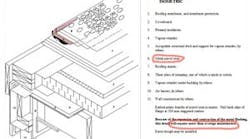In the art of designing low-slope membrane roofing systems, the industry has been bogged down by troublesome details that require frequent repair. The most egregious of these are metal roof edge details.
While we boast about 20- or 30-year warranties for our roof systems, we carefully exclude the ubiquitous gravel stop edges from the warranty. One reason for this is that roofing material manufacturers in general don’t produce or market the roof edge metal systems. While manufacturers’ roofing manuals may contain drawings showing such features, there is invariably a disclaimer, such as “This detail will require more than average maintenance.” According to the National Roofing Contractors Association (NRCA), it’s best to avoid flashing details that require rigid metal flanges to be embedded or sandwiched into the roof membrane whenever possible.
One “fix” that is sometimes recommended is elevating the gravel stop edge above the plane of the roof and pitching roof water away from the building edge towards interior roof drains. This won’t solve the metal movement and consequential splitting of the stripping plies, but at least water is not running into the splits, which rots the supporting wood nailers and eventually leaks into the building interior.
The typical sequence involves installing the roof membrane and embedded metal and topping it with stripping plies. In the real world, these stripping plies crack, especially if a metal cap is used to join fascia edging together. Just walking the perimeter of a building and visually examining the fascia metal will let you know if there is such a problem.
When metal is embedded, the edge metal also serves as a gravel stop, so it will be necessary to spud (chip) back the gravel, remove the torn stripping plies, and install new stripping, consisting either of ply felts, glass mesh, or (more recently) modified bitumen. After a couple of years, we can expect to do this again and again.
This is helped somewhat when flashing membrane – something more flexible and tougher than the roof membrane itself – covers the roofing plies and extends down the exterior blocking. The flange of the metal fascia is placed on top of the installed membrane, rather than being sandwiched. This flexible flashing at least achieves the goal of directing the water to the outside the building instead of the interior.
PageBreakWhen the entire roof membrane consists of a highly flexible roof membrane, such as EPDM rubber, the membrane itself is turned down the outside edge of the wood blocking. But then, often the failure is due to an adhesive failure between the metal and the EPDM sheet. Water can then enter through the nail holes from the attachment of the gravel stop metal to the wood blocking.
The Architectural Sheet Metal Manual by the Sheet Metal and Air Conditioning Contractors National Association (SMACNA) tells us that a 10-foot-long piece of galvanized steel edge metal can be expected to move 5/64ths of an inch with a 100°F temperature change (hot day and cold night). That cyclical movement is enough to fatigue and eventually rupture the stripping plies.
In addition to the thermal problems, studies of roofing failures during high wind events reveals that most blow-offs begin with roof edge failure. As demonstrated by Metal-Era, one of the leading manufacturers of improved fascia design:
The roof is widely recognized as one of the most vulnerable parts of a building. Of the various components of a roof, the roof edge is the most critical because of the way in which wind acts on a building. Commonly the roof edge receives little attention. It is considered simply an add-on accessory; however, careful selection of an appropriately tested edge is necessary to guard against the effects of potential wind damage. In addition to longevity issues, a tested edge is required by building code in many states and municipalities.
A document that addresses wind effects on roof edges — ANSI/SPRI/FM 4435-ES-1 2010 Wind Design Standard for Edge Systems Used with Low Slope Roofing Systems — is available for download free of charge from Single Ply Roofing Industry (SPRI) at www.spri.org. Inside, you’ll find test methods to determine wind resistance of fascia and coping systems and resistance to membrane shrinkage. Building codes are incorporating ES-1 2010 into their requirements.
Still another issue with roof edges pertains to the wood nailers. Our industry has generally used treated wood for nailers. The treatment, copper chromium arsenate (CCA), is no longer available, and in its place, wood treated with higher levels of copper but no arsenic is supplied. This, in turn, has raised questions about galvanic corrosion between steel fasteners and the high copper content wood. This has lead to NRCA now recommending that untreated wood be used as blocking, rather than treated wood.
The good news is that we now have edge details available which meet both the wind resistance requirements of ES-1 2010 and the thermal problems of embedded metal.
Richard (Dick) L. Fricklas was technical director emeritus of the Roofing Industry Educational Institute prior to his retirement. He is co-author of The Manual of Low Slope Roofing Systems and continues to participate in seminars for the University of Wisconsin and RCI Inc. - The Institute of Roofing, Waterproofing, and Building Envelope Professionals. His honors include the William C. Cullen Award and Walter C. Voss Award from ASTM, the J. A. Piper Award from NRCA, and the James Q. McCawley Award from the MRCA. Dick holds honorary memberships in both ASTM and RCI Inc.
RELATED STORIES
Roofing: It’s Elementary, My Dear Watson!
With all the science that has taken place in the roofing industry over the past half-century, one wonders why so many mysteries and crimes remain to be solved.
Clearing the Air on Roof Air Leakage
There’s considerable disagreement on whether air barriers are of benefit in low-slope roofing systems.
Be aware of the many hazards that must be addressed to keep buildings operational.


